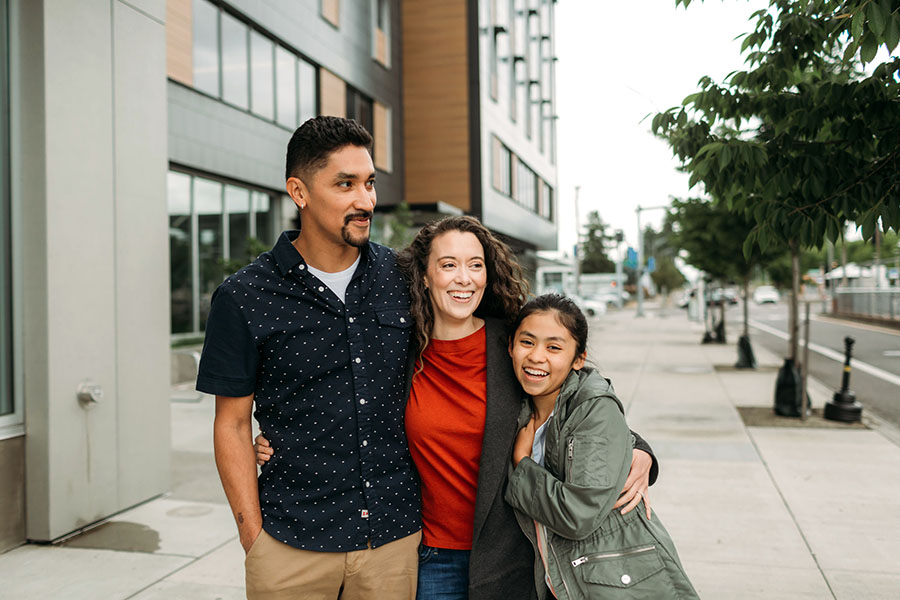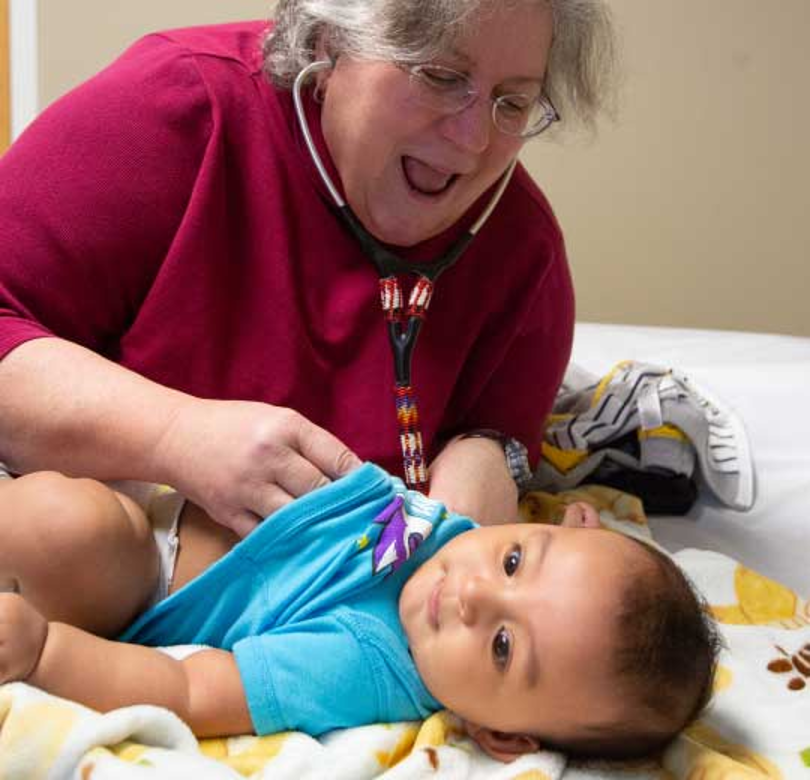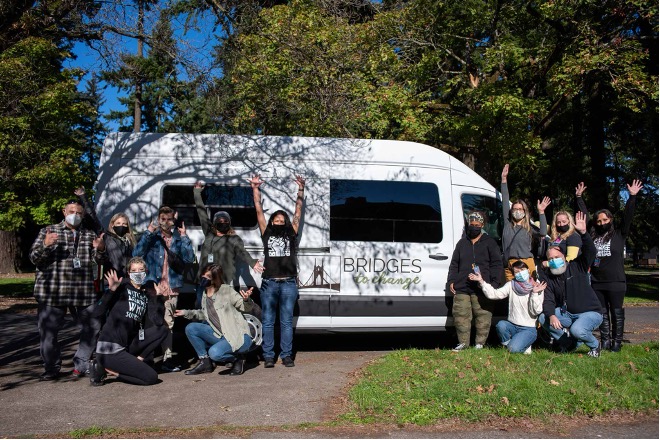CareOregon đã nỗ lực hết mình để cung cấp dịch vụ chăm sóc sức khỏe cho tất cả mọi người từ năm 1994 và trong thời gian đó, tổ chức đã đi đầu trong nhiều sáng kiến đổi mới nhằm cải thiện sức khỏe của người dân Oregon và cách họ tiếp nhận dịch vụ chăm sóc.
Ông Eric C. Hunter, Chủ tịch kiêm Giám đốc điều hành (CEO) của CareOregon cho biết: "Trọng tâm của chúng tôi vẫn không đổi kể từ ngày thành lập: giúp tiếp cận dịch vụ chăm sóc sức khỏe chất lượng cao một cách công bằng, có ý nghĩa cho các cộng đồng Oregon. Chúng tôi lắng nghe ý kiến đóng góp từ cộng đồng của mình và tập trung vào những gì quan trọng nhất đối với các hội viên cũng như tìm cách cung cấp các giải pháp đổi mới, hiệu quả."
Sự ra đời của CareOregon
Trên thực tế, bản thân CareOregon ra đời từ sự đổi mới.
Ngay từ những ngày đầu thành lập, chúng tôi đã hỗ trợ một nhóm dân số mà chúng tôi đầu tư toàn bộ vào. Mục đích này tiếp tục đóng vai trò là kim chỉ nam cho các quyết định của chúng tôi trong quá trình thích nghi với thực tế luôn thay đổi.
Ý tưởng thành lập CareOregon được khơi dậy từ cuộc nói chuyện vào năm 1993 giữa Billi Odegaard, giám đốc Sở Y tế Hạt Multnomah, và Tiến sĩ Peter Kohler, chủ tịch Đại học Khoa học Y tế Oregon (OHSU) lúc bấy giờ. Họ cùng quan tâm về việc liệu các công ty bảo hiểm thương mại tham gia Gói Oregon Health (OHP) sắp ra mắt có kinh nghiệm để đáp ứng nhu cầu riêng của bệnh nhân OHP hay không. Cuộc trò chuyện của họ nhanh chóng mở rộng để bao gồm Hiệp hội Chăm sóc Ban đầu Oregon và Ban Y tế Công cộng Hạt Clackamas.
Giải pháp đổi mới của họ: thành lập một ban giám đốc có nhiệm vụ tạo ra một gói chăm sóc có quản lý, phi truyền thống dành riêng cho người dân Oregon đang hưởng dịch vụ chăm sóc sức khỏe do nhà nước tài trợ. Một năm sau, CareOregon chính thức đi vào hoạt động vào ngày 1 tháng 2, 1994, cùng ngày OHP ghi danh những khách hàng đầu tiên. Ban đầu, CareOregon là một ban trực thuộc Sở Y tế Hạt Multnomah, đặt tại một văn phòng tạm thời tại OHSU.
Vào ngày 1 tháng 4, 1997, CareOregon đã trở thành tổ chức phi lợi nhuận của chính mình.
Trong vài thập kỷ qua, CareOregon đã phát triển thành một gia đình bao gồm CareOregon/Health Share, gói CareOregon Advantage Medicare, Housecall Providers, Columbia Pacific CCO, Jackson Care Connect và chương trình Phối hợp Chăm sóc cho người Mỹ bản địa.
CareOregon là mạng lưới an toàn của OHP
Trở lại năm 1993, cải cách y tế của tiểu bang liên quan đến việc chuyển Medicaid sang dịch vụ chăm sóc có quản lý theo đầu người. Chăm sóc theo đầu người hoàn toàn khác với cách trả lương cho các nhà cung cấp dịch vụ chăm sóc sức khỏe vào thời điểm đó. Với OHP, tiểu bang sẽ trả cho các công ty bảo hiểm một số tiền nhất định cho mỗi hội viên Medicaid mỗi tháng.
Vào đầu những năm 1990, hạt Multnomah và OHSU khác biệt ở chỗ cả hai đều có kinh nghiệm về dịch vụ chăm sóc có quản lý theo đầu người. OHSU đã đồng ý chịu rủi ro tài chính cho việc cung cấp dịch vụ chăm sóc tại bệnh viện và Hội đồng Ủy viên Hạt Multnomah đã bỏ phiếu chấp nhận rủi ro khi cung cấp dịch vụ chăm sóc ban đầu.
Tầm nhìn xa của những người sáng lập công ty chúng tôi đã được khẳng định năm năm sau đó khi nhiều công ty bảo hiểm thương mại rút khỏi OHP. Trong năm 1999-2000, CareOregon đóng vai trò là mạng lưới an toàn cho chính OHP. Chỉ còn lại chúng tôi vẫn tiếp tục cung cấp dịch vụ chăm sóc sức khỏe cho những người dân Oregon có nhu cầu.
Các giải pháp vượt trội
Sự đổi mới, hợp tác và lòng can đảm đã tiếp tục thúc đẩy sứ mệnh của chúng tôi. Luôn chú trọng đến sự ổn định trong tương lai cho bản thân và các đối tác, chúng tôi sẽ tính toán rủi ro nếu điều đó giúp chúng tôi hoàn thành tốt hơn sứ mệnh của mình. Chúng tôi xem xét những thách thức của riêng mình và hỏi các đối tác về những thách thức của họ - và cách chúng tôi có thể giúp đỡ.
Trong năm 2000, cách tiếp cận đó đã dẫn đến việc CareOregon thành lập Mạng lưới Thông tin Y tế Cộng đồng Oregon (OCHIN) để cung cấp hỗ trợ và dịch vụ CNTT y tế cho sáu trung tâm y tế cộng đồng. OCHIN hiện đang phục vụ 500 tổ chức trên khắp Hoa Kỳ.
Vào năm 2004, với 12 phần trăm hội viên chiếm 60 phần trăm ngân sách, chúng tôi đã bắt đầu CareSupport, một chương trình quản lý chăm sóc đa ngành tích hợp các dịch vụ xã hội và tập trung vào các hội viên có nhiều tình trạng phức tạp. Cùng năm đó, CEO mới, Dave Ford, Giám đốc Vận hành (COO)/Giám đốc Tài chính (CFO) mới Fritz Rankin và ban giám đốc đã dẫn dắt những thay đổi lớn cả ở nội bộ lẫn bên ngoài nhằm tạo ra những khoản tiết kiệm đáng kể, cải thiện dịch vụ chăm sóc và đảm bảo tương lai của CareOregon.
Vào năm 2005, khi đối tác Central City Concern đang gặp khó khăn với việc cung cấp dịch vụ chăm sóc ban đầu tại Phòng khám Phố Cổ, chúng tôi đã trả tiền cho một bác sĩ tư vấn để đánh giá tình hình và đưa ra khuyến nghị. Phòng khám cuối cùng đã giành được danh hiệu từ Quỹ Robert Wood Johnson.
Cũng trong năm 2005, CareSupport đã phát triển thành chương trình CareSupport và Đổi mới hệ thống (CSSI). Chúng tôi đã làm việc với 48 nhà cung cấp trong mạng lưới để phát triển mô hình thanh toán dựa trên các biện pháp chất lượng phù hợp hơn với các nhà cung cấp Medicaid so với tiêu chuẩn trả lương theo hiệu suất và tài trợ 16 triệu đô cho các dự án cải thiện chất lượng. CSSI đã dẫn đến Mô hình cải cách dịch vụ chăm sóc ban đầu.
Vào năm 2009, khi Hạt East Multnomah thiếu một phòng khám của hạt để phục vụ các hội viên của chúng tôi - và không có địa điểm nào có sẵn để cho thuê - chúng tôi đã ký kết một thỏa thuận. Chúng tôi sẽ mua một tòa nhà để làm phòng khám, và Hạt Multnomah sẽ bố trí nhân viên làm việc tại đó. Trung tâm Y tế Cộng đồng Rockwood mở cửa vào năm sau đó.
Trong năm 2011-2012, sau khi Đạo luật Lập pháp và Chăm sóc Giá cả phải chăng của Oregon chuyển đổi chương trình Medicaid với các CCO và mở rộng tính đủ điều kiện tham gia Medicaid, chúng tôi đã giúp thành lập năm trong số 16 CCO của tiểu bang: Health Share of Oregon, Columbia Pacific CCO, Jackson Care Connect, Primary Health of Josephine County và Yamhill Community Care Organization.
CareOregon/Health Share: một hướng tiếp cận táo bạo nhằm cách mạng hóa Medicaid
Trong năm 2012, CareOregon đã thành lập các tổ chức chăm sóc phối hợp (CCO) như một bước phát triển tiếp theo của cải cách y tế. Năm đó, CareOregon giới thiệu Health Share of Oregon, một tổ chức chăm sóc phối hợp mang tính cách mạng trong thế giới chăm sóc sức khỏe. Các bệnh viện và chương trình bảo hiểm y tế cạnh tranh trong khu vực Portland, cũng như cả ba hạt, đã cùng chung tay thành lập một doanh nghiệp duy nhất, được thành lập chỉ để phục vụ những người nhận Medicaid.
Vào thời điểm đó, CareOregon là đơn vị tiên phong được công nhận trên toàn quốc về các phương pháp tiếp cận đổi mới đối với Medicaid. Mặc dù sự đổi mới là một phần quan trọng trong hoạt động của chúng tôi, với tư cách là một công ty bảo hiểm đơn lẻ chỉ cung cấp các dịch vụ sức khỏe thể chất vào thời điểm đó, khả năng phát triển một hệ thống chăm sóc tích hợp để đáp ứng tốt hơn nhu cầu của khu vực vẫn còn hạn chế.
Cùng với việc hợp tác trong Health Share, chúng tôi đã tiếp tục truyền thống đổi mới của riêng mình. Chúng tôi bố trí nhân viên tại các phòng khám để cung cấp dịch vụ công tác xã hội và xem xét hồ sơ, tìm kiếm những thiếu sót trong việc chăm sóc. Các ưu đãi thanh toán của chúng tôi hỗ trợ các nhà cung cấp dịch vụ chăm sóc ban đầu trong việc tích hợp sức khỏe răng miệng và sức khỏe hành vi với sức khỏe thể chất và để đạt được các chỉ số của tiểu bang.
Chúng tôi đang giúp các phòng khám nha khoa và chăm sóc ban đầu kết hợp các dịch vụ của họ và giao tiếp cũng như phối hợp chăm sóc tốt hơn trên toàn hệ thống. Ban Tư vấn Cộng đồng của chúng tôi họp thường xuyên và cân nhắc về các sáng kiến hướng tới hội viên. Quỹ phúc lợi cộng đồng ưu tiên các yếu tố xã hội quyết định sự chênh lệch về sức khỏe và sức khỏe. Đội ngũ Nhà thuốc cố gắng kiểm soát chi phí thuốc. Và các dịch vụ hỗ trợ của chúng tôi - tiếp cận ngôn ngữ và NEMT - giúp lấp đầy khoảng cách thực tế giữa việc tiếp cận dịch vụ chăm sóc và thực sự nhận và hiểu sự chăm sóc đó.
Vào năm 2015, đội ngũ nhà thuốc đã ra mắt MEDS Ed, một loạt chương trình giáo dục liên tục với các chuyên gia y tế nội bộ và bên ngoài tìm hiểu các chủ đề liên quan đến các bác sĩ lâm sàng chăm sóc bệnh nhân tại các phòng khám cộng đồng. Điều này đã mang đến cho hàng ngàn nhân viên y tế ở Oregon và trên toàn thế giới cơ hội tìm hiểu thêm về các chủ đề để theo kịp các phương pháp tốt nhất.
Đổi mới sức khỏe hành vi
Đội ngũ Sức khỏe Hành vi của chúng tôi đã dành ra năm 2019 để sẵn sàng chuyển tiếp các quyền lợi về sức khỏe tinh thần và điều trị rối loạn sử dụng chất gây nghiện từ các hạt Clackamas, Multnomah và Washington sang CareOregon vào ngày 16 tháng 12, 2019. Việc mang lại quyền lợi nội bộ đã mang đến cho CareOregon cơ hội hợp tác với các nhà cung cấp theo nhiều cách khác nhau để tạo ra các mô hình thanh toán hỗ trợ dịch vụ chăm sóc tích hợp.
CareOregon đã dành ra năm 2019 để xây dựng cơ sở hạ tầng nhằm chuyển giao và phục vụ gần 200 hợp đồng với nhà cung cấp dịch vụ chăm sóc sức khỏe hành vi. Với sự thay đổi này, chúng tôi bắt đầu phục vụ tất cả các hội viên Health Share of Oregon vì lợi ích sức khỏe hành vi của họ. Chúng tôi cũng bắt đầu làm việc với các nhà cung cấp dịch vụ cai nghiện và sức khỏe tinh thần theo văn hóa để cùng thiết kế một mô hình thanh toán hỗ trợ khả năng cung cấp dịch vụ chăm sóc của họ nhằm giảm sự chênh lệch về sức khỏe.
Chỉ riêng trong năm 2022, chúng tôi đã đầu tư 92 triệu đô cho việc điều trị sức khỏe tinh thần và cai nghiện chất gây nghiện trên toàn tiểu bang, củng cố hệ thống chăm sóc sức khỏe hành vi ở khu vực Portland và khu vực Columbia Pacific và hỗ trợ hệ thống dịch vụ phục hồi ở Hạt Jackson.
Trong đại dịch COVID-19, chúng tôi đã cung cấp thông tin y tế chính xác, dịch vụ chăm sóc phù hợp với văn hóa và dịch vụ phiên dịch. Chúng tôi đã hợp tác với các đối tác để hỗ trợ việc tiếp cận vắc-xin một cách thiết thực bất kể hạn chế về thể chất hoặc tình hình nhà ở của mỗi cá nhân. Thông qua quan hệ đối tác và các sáng kiến nội bộ, chúng tôi nỗ lực rất nhiều để thực hiện cam kết tiếp cận vắc-xin và công bằng.
Đại dịch cũng kéo theo sự mở rộng của các dịch vụ y tế từ xa của chúng tôi, cho phép các hội viên tiếp cận dịch vụ chăm sóc tại nhà. Trong 2020, chúng tôi đã giải ngân hơn 1 triệu đô tài trợ liên quan đến COVID. Chúng tôi đã giúp trẻ em vơi đi những tháng ngày cô đơn trong đại dịch bằng cách tài trợ "Hộp chăm sóc gia đình" với các trò chơi, sách và đồ chơi phù hợp với văn hóa của mỗi gia đình.
Vào năm 2021, khoản đầu tư trị giá 2021,2 triệu đô từ CareOregon đã giúp Sở Cứu hỏa & Cứu hộ Portland triển khai chương trình Đánh giá và điều trị sức khỏe cộng đồng (CHAT) tại bộ phận y tế cộng đồng mới thành lập của cơ quan này. Với mục tiêu cải thiện tính công bằng và khả năng tiếp cận, chương trình thí điểm đã giúp giải quyết một vấn đề bất cập lớn về sức khỏe cộng đồng.
Tiếp nối di sản đổi mới
Gần đây, chúng tôi đã làm việc chăm chỉ để tiếp cận với các cộng đồng chưa được phục vụ thông qua Chương trình hỗ trợ nhân viên y tế truyền thống, hợp tác với tám tổ chức phi lợi nhuận tại cộng đồng để phục vụ tốt hơn các cộng đồng nói tiếng Tây Ban Nha, người Châu Á và người Mỹ bản địa trong tiểu bang của chúng tôi.
Và chúng tôi đã tiếp thu quan điểm rằng "nhà ở là sức khỏe", nhận ra mối liên hệ giữa nhà ở ổn định và sức khỏe tốt hơn. Tại Columbia Pacific, chúng tôi đã khai trương Trillium House vào tháng 6 năm 2023, thêm 42 đơn vị nhà ở giá cả phải chăng ở Hạt Clatsop, nơi có tỷ lệ vô gia cư bình quân đầu người cao nhất của tiểu bang.
Vào tháng 8 năm 2024, chúng tôi đã khai trương chung cư Hawk's Eye Apartments ở Hạt Clatsop, chuyển đổi một khách sạn cũ thành nhà ở cho hai nhóm đối tượng: các thành viên cộng đồng có thu nhập thấp cần hỗ trợ sức khỏe hành vi và các chuyên gia làm việc cho các tổ chức thuộc mạng lưới an toàn xã hội và chăm sóc sức khỏe.
Trong tương lai, CareOregon vẫn cam kết tìm ra những phương pháp mang tính chuyển đổi để đáp ứng nhu cầu của các hội viên tại nơi họ đang ở. Chúng tôi sẽ tiếp tục lắng nghe ý kiến đóng góp từ các hội viên và cộng đồng của mình và củng cố cam kết của mình về dịch vụ chăm sóc dựa trên cộng đồng.
Khi bối cảnh chăm sóc sức khỏe quốc gia tiếp tục thay đổi do áp lực thị trường và sự hợp nhất, CareOregon sẽ tìm kiếm các mối quan hệ đối tác mới và sáng tạo để đảm bảo có một lựa chọn phi lợi nhuận khả thi ở Oregon trong tương lai.
Ông Hunter chia sẻ: "Trong Lễ hội Hoa hồng, các biển quảng cáo của chúng tôi có nội dung: 'Chúng tôi kết hợp dịch vụ chăm sóc và Oregon lại với nhau'. Đó là trọng tâm của việc chúng tôi là ai. Sứ mệnh nằm ngay trong tên của chúng tôi và đó là lý do tại sao chúng tôi có mặt ở đây - bây giờ và trong ba mươi năm tới!"





